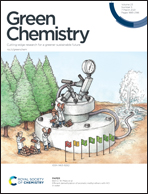Mechanochemical preparation of thermoplastic cellulose oleate by ball milling†
Abstract
Cellulose is the most abundant natural macromolecular material, which offers a potential alternative feedstock to petroleum-based polymers. However, the large-scale and sustainable transformation of this biomass into available bio-plastics is still a challenge due to its inherent recalcitrance. Here, a sustainable esterification strategy of cellulose was developed to efficiently synthesize cellulose oleate (COE) by ball milling to endow cellulose with thermoplasticity. In this strategy, a low dosage of oleic acid (6 mol per anhydroglucose) and no solvent were used to achieve the goal during the ball-milling process. According to differential scanning calorimetry (DSC) analysis, the synthesized COEs possessed two major glass transitions at 25.6 °C–57.3 °C and 153.8 °C–172.5 °C corresponding to the motion of oleic side chains and cellulose backbones, respectively. Besides, the prepared COEs with a high degree of substitution (DS, 2.34–2.55) can be readily processed into homogeneous films with flexibility, transparency, and hydrophobicity by hot-pressing at 160 °C. This strategy is advantageous over traditional methods in the aspects of reduced reactant dosage, improved sustainability, and enhanced efficiency, which represents a potential green route to fabricate melt-processable cellulose esters in industry.



 Please wait while we load your content...
Please wait while we load your content...